#abraxas amulet
Explore tagged Tumblr posts
Text

collection of ancient amulets and various wizard knick knacks
#abraxas#abraxas amulet#hekate#amulets#talismans#intaglio#ancient greek amulet#gnosticism#occultism#magic#witchy aesthetic
20 notes
·
View notes
Text
youtube
Victoria and Albert Museum / Gemstones & Amulets ASMR
#amulets#minerals#Youtube#archaeology#abraxas#tetragrammaton#quartz#bloodstone#turqouise#jade#sapphire#antique books
5 notes
·
View notes
Text



Runes of Yggdrasil Talon Abraxas RUNES Runes are woven into Norse religion and are closely associated with Norse magic (seiðr) and skaldic poetry. The runes were not invented. The old poem Hávamál explains that Odin discovered the runes when he hung himself from the world tree Yggdrasil in order to learn wisdom. He hung on the wind-blown tree for nine nights and days. Just as he was about to die, he found the runes, grabbed them and earned his life.
A more prosaic explanation is that the runes were developed in the firsth century AD, possibly inspired by the Latin alphabet. Although used by all Germanic peoples, most of them, however, are discovered in Scandinavia. Runes have a form such that they are easy to carve into a hard material. Note that one does not write but rather carves a rune.
Runes were carved on weapons, tools, jewellery, amulets, bones, pieces of wood, memorial stones, church walls etc.
Sometimes the runic inscription is read from left to right, sometimes from right to left.
Runes constitute contemporary documentation, but it can be difficult to decipher the runes and there are often several interpretations of an inscription. Den eldre futharken
The elder Futhark
THERE ARE SEVERAL RUNIC ALPHABETS The two main types of runic alphabet are called the elder Futhark and the younger Futhark after the sequence of the first six runic letters. The runes of the Middle Ages are relatively similar to the younger Futhark, but are characterised by pricks that shall differentiate between individual sounds such, for example, as P and D.
In addition, there is a sequence of local variants. Runic script existed simultaneously with the Latin alphabet and was in use up the 1500s. In Dalarne in Sweden, a particular type of runic script was in use up until approximately 1900.
The elder Futhark: 24 characters. These were in use from approx. 100 to 800 AD. The younger Futhark: 16 characters. These were in use from approx. 800 AD to 1100 AD. Medieval runes: 23 runes. Used from approx. 1100 to 1500 AD.
87 notes
·
View notes
Text
Writing Reference: 5 Symbols
for your next poem/story (pt. 3)
CAULDRON

In understanding symbols, sometimes it is useful to simply look at the shape and see what it resembles.
The traditional cauldron represents nothing so much as the belly of a pregnant woman and, unsurprisingly, it is an important female symbol all over the world.
The circular shape of the cauldron gives another clue; the circle is a symbol of never-ending life and regeneration, and these themes recur repeatedly in stories containing cauldron symbolism.
The way the cauldron is used also gives a hint about its symbolic meaning.
Things are put into the cauldron, heated, and something different is taken out; the basic ingredients are transformed.
Therefore, the cauldron also symbolizes germination and transformation.
Traditionally, cauldrons have three legs:
The number 3 in this instance represents the triple aspect of the Great Goddess, or the three fates.
Shakespeare alludes to this when the three Weird Sisters—arguably the most famous witches in literature—cook up trouble at the beginning of Macbeth.
In pre-Christian literature, countless legends feature magical cauldrons, and it may be because of this that the cauldron has its witchy associations.
Celtic tales tell of cauldrons that contain an unending supply of food or of knowledge.
The dead are frequently thrown into a magical Cauldron of Rebirth and climb out the next day, alive once more.
Mythical warriors and heroes who died in battle are restored to life in this way.
Ceridwen (one of the most powerful witches in all of Celtic mythology and is typically depicted as simultaneously a mother and a wise woman) had a cauldron full of inspiration and magical powers.
In India, a magic life-giving food, called Soma, was brewed in three huge bottomless cauldrons.
In Greece, there are tales in which an ordeal of initiation involves the person boiling in a cauldron, but after the rite, the initiate emerges with magical powers, including the gift of immortality.
CHNOUBIS

The Chnoubis is a hybrid creature, with the head of a lion and the tail of a serpent.
It was carved onto stones for use as an amulet, providing protection against poisons in particular.
Amulets featuring the Chnoubis date back to the first century and it is supposed that this odd-looking creature may be related to Abraxas, whose image was used in a similar way.
CLADDAGH

The Claddagh is a popular symbol, often incorporated into the design of rings.
Traditionally used as a wedding ring, it is so-called because it was originally made in a Galway fishing village of the same name in 17th century Ireland.
However, the elements of the design are much older, stretching back into pre-Christian Celtic history.
The Romans had a popular ring design, the Fede, which featured clasped hands.
“Fede” means “fidelity.”
The Claddagh symbol features a heart held by a pair of hands.
A crown usually surmounts the heart.
These features represent love, friendship, and loyalty.
CORNUCOPIA

Also called the Horn of Plenty, the cornucopia is often depicted in paintings and on friezes where it symbolizes the notion of boundless abundance, as flowers, fruits, sheaves of wheat, and other produce spill out of a hollow horn or a twisting basket woven in the shape of the horn.
The origin of the cornucopia is found in the Greek myth of Amalthea.
Amalthea fed the infant Zeus a drink of goat’s milk and was given the brimming goat’s horn as a reward.
Sometimes the infant Zeus is depicted being fed the milk from the horn itself.
The Cornucopia, as a symbol of a bounteous harvest, is also associated with Ceres, the Goddess of corn, and also with Fortuna, Goddess of good fortune.
CROSSROADS

In fairy stories and myths, it is often at the crossroads where mischief awaits, usually in the form of other-worldly spirits.
Effectively, the crossroads symbolizes the intersection of two paths, making four potential routes, and a place where a decision must be made, not only practically, but metaphorically too.
The X of the crossroads marks a spot where two worlds meet.
The origins of this story go back to African folklore, where a deity called Esu was the guardian of the crossroads.
When Christianity took over, these old Gods were, quite literally, demonized, and Esu was transformed into the Devil.
Hecate, too, personified as the Queen of the Witches, was called the Goddess of the Crossroads.
In Celtic mythology, corpses belonging to those considered “unholy” were buried at crossroads in order to prevent them coming back to life and because the crossroads was a Gate to the Otherworld. Gibbets were placed at crossroads for the same reason.
Source ⚜ More: On Symbols ⚜ Writing Notes & References
#writing reference#symbolism#symbols#writeblr#halloween#spilled ink#dark academia#witchblr#literature#writers on tumblr#writing prompt#poetry#poets on tumblr#writing inspiration#creative writing#light academia#writing inspo#writing ideas#mythology#folklore#writing resources
60 notes
·
View notes
Text

Rahu Ketu : Oroborous : Abraxas Carl Jung said : "This is a god whom ye knew not, for mankind forgot it. We name it by its name Abraxas. It is more indefinite still than god and devil." - C.G. Jung
Hard to know is the deity of Abraxas. Its power is the greatest, because man perceiveth it not. From the sun he draweth the summum bonum [highest good]; from the devil the infimum malum [lowest evil]; but from Abraxas life, altogether indefinite, the mother of good and evil. Smaller and weaker life seemeth to be than the summum bonum; wherefore is it also hard to conceive that Abraxas transcendeth even the sun in power, who is himself the radiant source of all the force of life.
Abraxas is the sun, and at the same time the eternally sucking gorge of the void, the belittling and dismembering devil. The power of Abraxas is twofold; but ye see it not, because for your eyes the warring opposites of this power are extinguished.
"Abraxas is the god whom it is difficult to know. His power is the very greatest, because man does not perceive it at all. He is magnificent even as the lion at the very moment when he strikes his prey down. His beauty is like the beauty of a spring morn. To see him means blindness; To know him is sickness; To worship him is death; To fear him is wisdom; Not to resist him means liberation … Such is the terrible Abraxas … He is both the radiance and the dark shadow of man. He is deceitful reality."
Abraxas, sequence of Greek letters considered as a word and formerly inscribed on charms, amulets, and gems in the belief that it possessed magical qualities. In the 2nd century ad, some Gnostic and other dualistic sects, which viewed matter as evil and the spirit as good and held that salvation came through esoteric knowledge, or gnosis, personified Abraxas and initiated a cult sometimes related to worship of the sun god. Basilides of Egypt, an early 2nd-century Gnostic teacher, viewed Abraxas as the supreme deity and the source of divine emanations, the ruler of all the 365 heavens, or circles of creation—one for each day of the year. The number 365 corresponds to the numerical value of the seven Greek letters that form the word abraxas.
24 notes
·
View notes
Note
In Amulet what were Tom and Alphard's respective first impressions of each other upon meeting for the first time in school? I love your writing btw. Thank you for existing.
Oooh! Praise! (Look @therealvinelle, praise!)
Amulette d'Amour by me and @therealvinelle
Though the way @therealvinelle and I often write this would be pretty much the same as their first impressions in The Man Who Would Be King and anywhere else unless clearly stated.
A lot of this has been hinted at/covered in both of these fics to some degree so the best thing to do is read the fics. It also may come up more as stories go on.
The long and short of it is though that Alphard's initial first impression was "oh Muggle-born in Slytherin, huh, poor life choices" which immediately and violently switched to "who the fuck is this demon and oh dear god I'm in a room with him for seven years and the rest of my life will be nothing but PAIN and TERROR".
Tom's first impression of Alphard was "boring", "weak", and "kind of dumb but not as dumb as Abraxas".
#harry potter#amulette d'amour#the man who would be king#alphard black#tom riddle#alphard black/tom riddle#alphalord#meta#vinelle#therealvinelle#praise
42 notes
·
View notes
Text
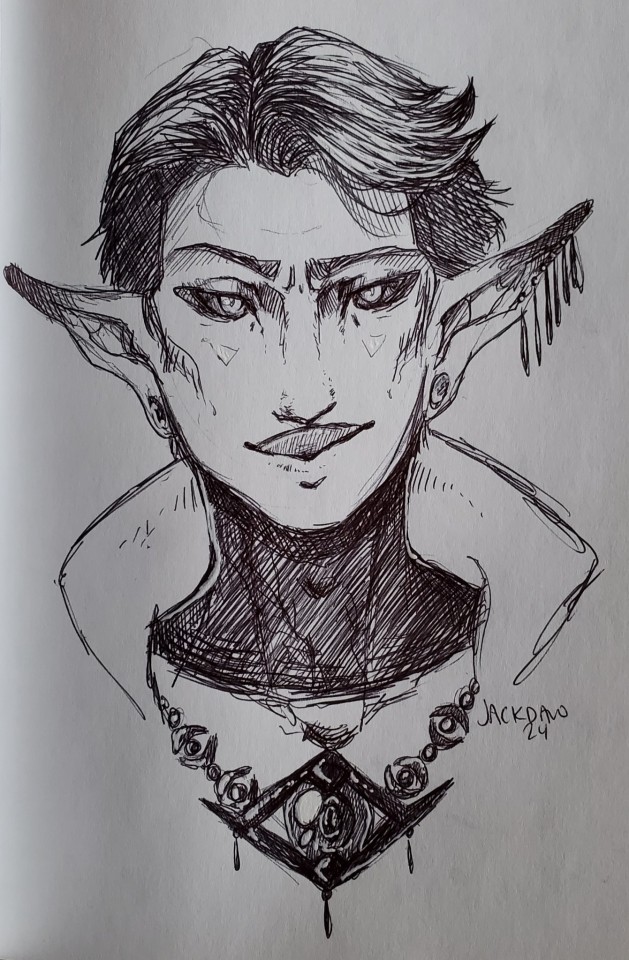

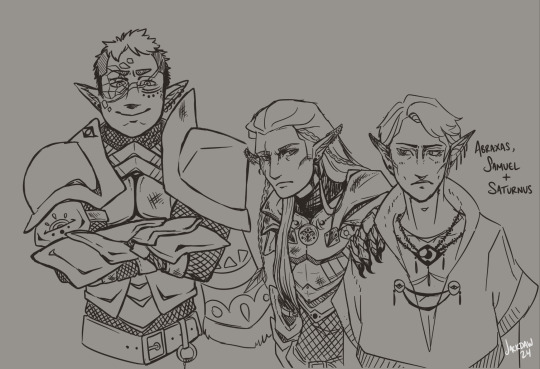
Some sketches of my fire genasi Aberrant Mind Sorcerer, Abraxas son of Magnus, inspired by TMA.
Abra's a cranky, power thirsty diva with some homicidal tendencies, who turned his back on his previous adventuring party in pursuit of powerful artifacts. Some bullshit occurs, and he crosses the gith and ends up stuffed in a stasis flask and flung to the far reaches of the Astral sea. Nearly 300 years later, a rift in reality brings his flask hurtling to the ground at the feet of his current companions.
My DM homebrewed an eldritch amulet for me, connected to The Beholding. (He's also a TMA fan, so we had a lot of fun)
#dungeons and dragons#d&d#d&d 5e#aberrant mind sorcerer#the magnus archives#jonathan sims#the beholding#the eye#fire genasi#he's a genie in a bottle lmao#this started as a bad joke#please send help he's so sassy
18 notes
·
View notes
Text
#aFactADay2024
#1425: abracadabra is one of those words of uncertain origin, to nobody's surprise. it could be a reduplication on the Greek alphabet ΑΒΓΔ; it could be from Latin abraxas (which seems most historically supported); it could be an entire Hebrew or Aramaic phrase; it could actually be a god-given collection of sounds that, when uttered, cause the rules of physics to bend to the magician's will. who knows. my favourite theory is that it's a "barbarous name" - a word originally derived from unintelligible languages (often Ancient Egyptian, Hebrew or Persian) into Greek (hence barbarous) that would just be used for their sound as a generic magical word. ancient Greek magicians were warned not to attempt to understand what the barbarous names actually meant, because that would ruin the magic. this meant they did get quite quickly corrupted... people used to believe in genuine magic of uttering words like Abracadabra - amulets reading ABRACADABRA spelt out in a triangle, each line one letter shorter than the previous, were popular as healing talismans
0 notes
Text
Good Luck Magical Talisman of Abraxas to Control Your Life with the Spirits Best Money Amulet Stainless Steel Pendant Necklace
Occasion: Party Compatibility: All Compatible Pendant Size: 35mm * 38mm Shapepattern: Round Model Number: HLSS231 Material: Metal Chain Type: Link Chain Style: TRENDY Necklace Type: Pendant Necklaces Gender: Unisex Metals Type: STAINLESS STEEL Brand Name: apricot fu Origin: Mainland China CN: Zhejiang Fine or Fashion: fashion Item Type: NECKLACES Notice: We are manufacturer, we can produce…
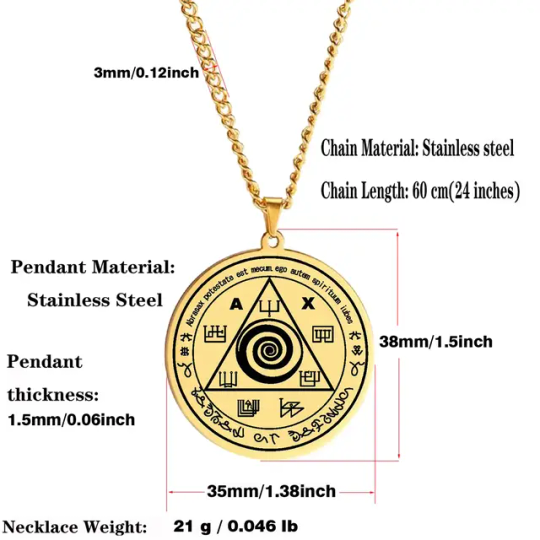
View On WordPress
0 notes
Photo

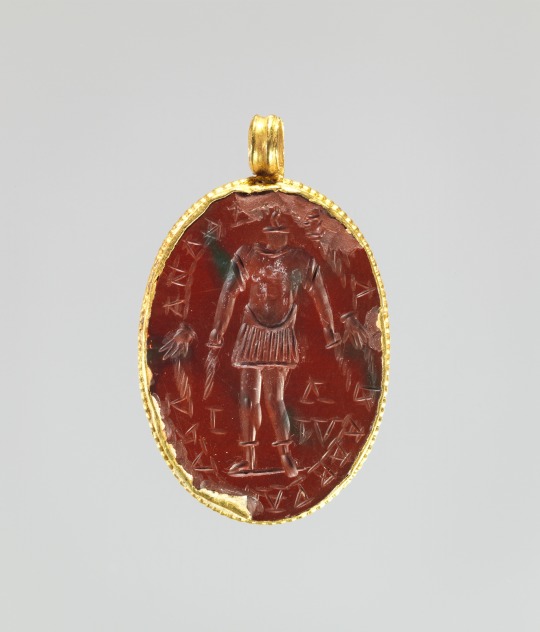
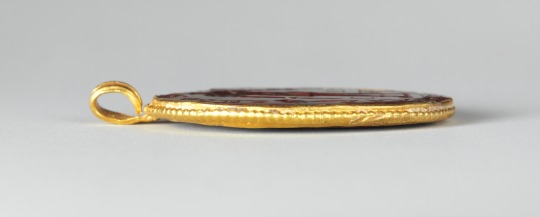
An ancient jasper intaglio magical amulet known as an Abraxas Stone featuring a cock-headed anguiped (”snake-legged god”) identified as Abrasax or Abraxas. Dated to 2nd-3rd century AD Rome, from the Metropolitan Museum of Art.
#Abraxas#Abrasax#Abraxas Stone#Rome#Imperial Rome#Ancient Rome#esotericism#paganism#pagan#Roman#Imperial Roman#Ancient Roman#ancient history#amulet#talisman#The Met#Metropolitan Museum of Art#antiquities#2nd century AD#3rd century AD#ancient#magic#magick#magical#magickal#relic#artifact
346 notes
·
View notes
Text

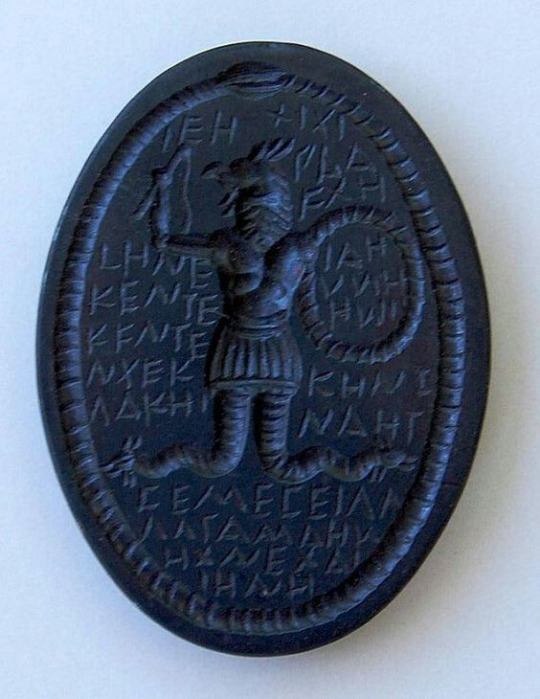
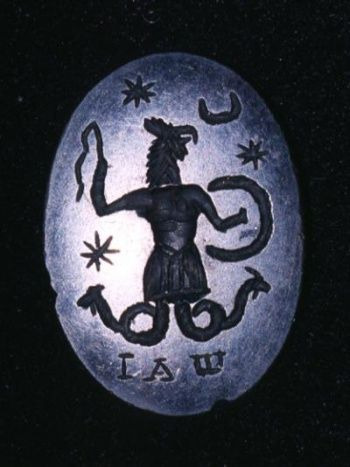
Abraxas amulets
74 notes
·
View notes
Text

Abraxas Abraxasor Abrasax (Gnostic, from the Greek Αβραξας) From The Theosophical Glossary: "Mystical term used by the Gnostics to indicate the supreme entity of our cosmic hierarchy or its manifestation in the human being which they called the Christos. Abraxas has the value of 365, based on numerical equivalents of the Greek alphabet. Because 365 represents the cycle of one revolution of our planet around the sun, they held that in Abraxas were mystically contained the full number of families of entities composing a hierarchy. These entities received from their supreme illuminator, Abraxas, the streams of life and inspiration governing their existence. Thus in a sense Abraxas is the cosmic Oversoul, the creative or Third Logos, Brahma. The Basilidean Gnostics [see: Basilides] taught that from this supreme God was created nous (mind). Abraxas also was identified with the Hebrew 'Adonai, the Egyptian Horus, and the Hindu Prajapati. Gnostic amulets known as Abraxas gems depicted the god as a pantheos (all-god), with the head of a cock, herald of the sun, representing foresight and vigilance; a human body clothed in armor, suggestive of guardian power; legs in the form of sacred asps. In his right hand is a scourge, emblem of authority; on his left arm a shield emblazoned with a word of power. This pantheos is invariably inscribed with his proper name IAO and his epithets Abraxas and Sabaoth, and often accompanied with invocations such as SEMES EILAM, the eternal sun (Gnostics and Their Remains 246), which Blavatsky equates with "the central spiritual sun" of the Qabbalists (SD 2:214). Though written in Greek characters, the words SEMES EILAM ABRASAX are probably Semitic in origin: shemesh sun; `olam secret, occult, hid, eternity, world; Abrasax Abraxas. Hence in combination the phrase may be rendered "the eternal sun Abraxax." "Remember, beloved devotee, the double tail of the serpent that forms the legs of the solar rooster of Abraxas. The entire process of the Great Work consists of releasing oneself from the enchanted rings of the tempting serpent..." Samael Aun Weor, The Aquarian Message
115 notes
·
View notes
Text

A B R A C A D A B R A
The word Abracadabra is said to derive from an Aramaic phrase meaning "I create as I speak." However אברא כדברא in Aramaic is more reasonably translated as "I create like the Word."
In the beginning was the Word, and the Word was with God, and the Word was God. He was with God in the beginning. Through him all things were made."
In the beginning was the Word: the Logos, the sound frequency (vibration).
We know that speech means not just any kind of a vibration, but a vibration that carries information.
Thus, I create like the Word.
In the Hebrew language, the phrase translates more accurately as "it came to pass as it was spoken."
History:
The first known mention of the word was in the third century AD in the work Liber Medicinalis by Quintus Serenus Sammonicus, a physician to the Roman emperor, who suggests to wear an amulet containing the word written in the form of a triangle:
A - B - R - A - C - A - D - A - B - R - A A - B - R - A - C - A - D - A - B - R A - B - R - A - C - A - D - A - B A - B - R - A - C - A - D - A A - B - R - A - C - A - D A - B - R - A - C - A A - B - R - A - C A - B - R - A A - B - R A - B A
Abracadabra and the Gnostics:
Abracadabra was used as a magical formula by the Gnostics of the sect of Basilides in invoking the aid of beneficent spirits against disease and misfortune. It is found on Abraxas stones, which were worn as amulets. Subsequently, its use spread beyond the Gnostics.
Abraxas:
Have you ever been mesmerized while waiting for the sunrise? As you watch the horizon for that first burst of light, you get swept up in the eternal present moment. With baited breath, your sense of time is suspended, and you’re primed for a miracle. This is the “liminal zone,” the threshold between night and day, between here and there, between this and that. It’s the crossroads where anything is possible. And then the dawn breaks through, like a sudden burst of inspiration, like an act of creation: “Let there be light.” That is the magic of Abraxas, an enigmatic name that has perhaps always been closely associated with the power of the sun. This strange, mysterious name captures that magical, suspended, timeless moment: “all of time as an eternal instant.” Abraxas is the power of infinity—the promise of endless possibilities, the “cosmos” itself. In mythology, Abraxas is the name of a celestial horse that draws the dawn goddess Aurora across the sky. The name suggests a power that is not properly ours but rather a gift from another world.
But what of the name’s origin? It is likely, as an etymologist posited in 1891, that Abraxas belongs “to no known speech” but rather some “mystic dialect,” perhaps taking its origin “from some supposed divine inspiration.” Yet scholars, of course, search for a root. There are speculatory shreds of evidence which suggest that Abraxas is a combination of two Egyptian words, abrak and sax, meaning “the honorable and hallowed word” or “the word is adorable.” Abrak is “found in the Bible as a salutation to Joseph by the Egyptians upon his accession to royal power.” Abraxas appears in “an Egyptian invocation to the Godhead, meaning ‘hurt me not.’” Other scholars suggest a Hebrew origin of the word, positing “a Grecized form of ha-berakhah, ‘the blessing,’” while still others speculate a derivation from the Greek habros and sac, “the beautiful, the glorious Savior.” The name has appeared in the ancient Hebrew/Aramaic mystical treatises The Book of Raziel and The Sword of Moses, and in post-Talmudic Jewish incantation texts, as well as in Persian mythology.
An interesting occurrence of Abraxas is found in a papyrus from late antiquity (perhaps from Hellenized Egypt, though its exact origin is unknown). The papyrus contains “magical recipes, invocations, and incantations,” and tells of a baboon disembarking the Sun boat and proclaiming: “Thou art the number of the year ABRAXAS.” This statement causes God to laugh seven times, and with the first laugh the “splendor [of light] shone through the whole universe.”
The Basilideans, a Gnostic sect founded in the 2nd century CE by Basilides of Alexandria, worshipped Abraxas as the “supreme and primordial creator” deity, “with all the infinite emanations.” The god Abraxas unites the opposites, including good and evil, the one and the many. He is “symbolized as a composite creature, with the body of a human being and the head of a rooster, and with each of his legs ending in a serpent.” His name is actually a mathematical formula: in Greek, the letters add up to 365, the days of the year and the number of eons (cycles of creation).
“That a name so sacredly guarded, so potent in its influence, should be preserved by mystic societies through the many ages . . . is significant,” notes Moses W. Redding, a scholar of secret societies. Redding suggests that only in Freemasonry has this “Divine Word” been “held in due reverence.”
In Kabbalah:
As a carpenter the creator employs tools to build a home, so G'd utilized the twenty-two letters of the alef-Beit (the Hebrew alphabet) to form heaven and earth. They are the metaphorical wood, stone and nails, cornerposts and crossbeams of our earthly and spiritual existence. As in abracadabra "Αύρα κατ' αύρα" אברא כדברא, as he, she, it created the universe with; the Letter, The word, and the number.
As Kabbalist sages say G'd created the alef-beit, before the creation of the world. "The Maggid of Mezritch" explains this on the basis of the first verse in the Book of Genesis “בראשית ברא אלקים את השמים ואת הארץ—In the beginning G'd created the heavens and the earth.” Beresheet Barah Elokim Et (in the beginning God created the) The word את, (es or et) is spelled with an aleph, the first letter of the aleph-beit, and a tav, which is the last. The fact is, את, es, is generally considered to be a superfluous word. There is no literal translation for it, and its function is primarily as a grammatical device. So why is “es” present twice in the very first line of the Torah? It suggests that in the beginning, it was not the heavens and the earth that were created first. It was literally the alef-beit, aleph through to tav. The alpha and the omega, Without these letters, the very Utterances with which G'd formed the universe would have been impossible the Baal Shem Tov explains the verse, “Forever the words of G'd are hanging in the heavens.”
The crucial thing to realize is that G'd, creator, source did not merely create the world once. His Her It's words didn’t just emerge and then evaporate. Rather, G'd continues to create the world anew each and every moment. His Her It's, words are there constantly, “hanging in the heavens.” And the alef-beit is the foundation of this ongoing process of creation.
According to Kabbalah, Cabbalah and Qabbalah sages and scholars, when the same letters are transposed to form different words, they retain the common energy of their shared gematria. Because of this, the words maintain a connection in the different forms. We find a classic example of this with the words (הצר, hatzar, troubles), (רצה, ratzah, a desire to run passionately into the “ark” of spiritual study and prayer) and (צהר, tzohar, a light that shines from within). All three words share the same three letters: tzaddik, reish and hei in different combinations. The Baal Shem Tov, explains, the connection between the words as follows: When one is experiencing troubles (hatzar), and one runs to study Spiritual txts and pray with great desire (ratzah), one is illuminated with a G'dly light from within (tzohar) that helps him or her transform there troubles into blessings, as it is said that the source of the twenty-two letters is even higher than that of the Ten Commandments.
As it states: “With you, is the essence of G'd", בך means “with you.” The (Beit which has a gematria of 2) and the (kaf = 20) added together equals 22. Through the twenty-two letters of the alef-Beit, we are all connected to the monad, G'd, Allah الله, the source, and each other through our words and language as words hold power as that which makes us All unique is language as language weaves everything together. These are the teachings of our holy teacher, as the The Zohar affirms that every sentence, every phrase, every word, and even every letter of the Bible exists simultaneously on several levels of meaning. This sacred work clearly declares, “Woe unto those who see in the Law nothing but simple narratives and ordinary words! . . . Every word of the Law contains an elevated sense and a sublime mystery.”
[Except from Path of the Sun Keepers by Paul Francis Young]
“Words have a magical power. They can bring either the greatest happiness or deepest despair; they can transfer knowledge from teacher to student; words enable the orator to sway his audience and dictate its decisions. Words are capable of arousing the strongest emotions and prompting all men's actions.” --Sigmund Freud
139 notes
·
View notes
Text
Somebody talked about how we need more horror media that has religious people actually meet their gods and discovering that they are nothing like how their own religion presents them (a concept I endorse wholeheartedly!). I suggested that one go into the seven-eyed ram-headed Jesus from Altered States, or have a story where God reveals his "true image" to a lucky individual and it turns out to be basically indistinguishable from the image of Baphomet, and I think it's that idea that has me getting hints of how far Satanism can go, how deep it can be, in order to really go beyond the humanism that is presented under its name. It's next to impossible at this point to sketch out what that amounts to, but something tells me that Zizek's secret ("God who created the world is evil. The devil.") may be a major part of that. Something like that isn't exactly without precadent in Satanism, and I believe one sees some aspect of this in Stanisław Przybyszewski's discussion of Satanism, wherein he expressly locates Satan and some attendant principle of evil as the inescapable source of creation. He explicitly refers to Satan as both the source of suffering and the creator of the world, and then the patron of magicians, the sexual principle, and, in a way, the sponsor of rebellion against the authority of the church and champion of the vengeance of the underclasses; the father both of the pains and agonies of life and also every wonder you can experience in life, including love. Of course where does that leave "God", and the rejection of it. I suppose from that standpoint one may always claim that he's falsely claiming himself to be the supreme principle of the universe, though in a way we're kind of dealing with a version of the premise of the many "Gnostic" sects of Christianity, perhaps even (in a sense) an inversion of the Sethian premise. Still, it would all make some sense from the idea that one comes to know reality by its other side, to know the truth a rebours, the location of inversion. It's all mere speculation anyway.
Also, I kind of like the idea of some "freaky" looking deities as almost the "gnostic forms" of various gods, a bit like the deities you see on gnostic talismans or amulets (the images of beings such as Chnoubis or Abraxas, which may or may not adapt their namesake from Egyptian gods), or like the "esoteric forms" of Indian gods as found in esoteric Buddhism or perhaps Tantric Hinduism, and I could do with more of that.

14 notes
·
View notes
Text

In the beginning was the Word, and the Word was with God, and the Word was God. He was with God in the beginning. Through him all things were made." In the beginning was the Word: the Logos, the sound frequency (vibration). We know that speech means not just any kind of a vibration, but a vibration that carries information. Thus, I create like the Word. In the Hebrew language, the phrase translates more accurately as "it came to pass as it was spoken." A - B - R - A - C - A - D - A - B - R - A A - B - R - A - C - A - D - A - B - R A - B - R - A - C - A - D - A - B A - B - R - A - C - A - D - A A - B - R - A - C - A - D A - B - R - A - C - A A - B - R - A - C A - B - R - A A - B - R A - B A Abracadabra and the Gnostics: Abracadabra was used as a magical formula by the Gnostics of the sect of Basilides in invoking the aid of beneficent spirits against disease and misfortune. It is found on Abraxas stones, which were worn as amulets. Subsequently, its use spread beyond the Gnostics. “Words have a magical power. They can bring either the greatest happiness or deepest despair; they can transfer knowledge from teacher to student; words enable the orator to sway his audience and dictate its decisions. Words are capable of arousing the strongest emotions and prompting all men's actions.” --Sigmund Freud Art by Denis Forkas Kostromitin.
21 notes
·
View notes
Photo
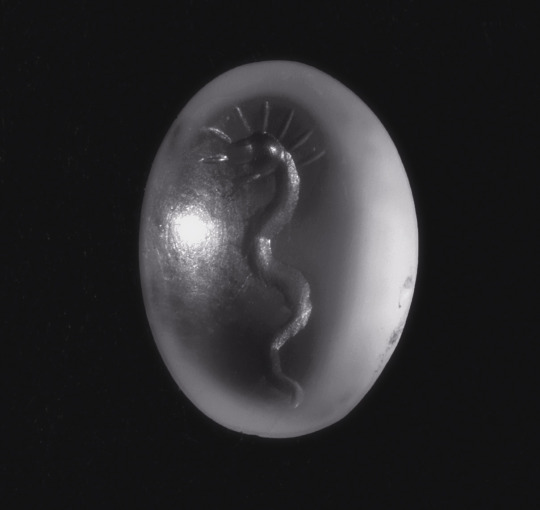
Chnoubis (Abraxas) amulet with a lion-headed snake, chalcedony, 1st-6th c., BM G173. © Genevra Kornbluth.
source
192 notes
·
View notes